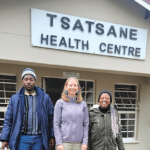- Half of men in the country smoke
- Women join the habit
Lesotho has emerged as one of Africa’s heaviest-smoking countries, with new data from the World Health Organisation (WHO) showing alarmingly high tobacco use rates, especially among men.
According to the WHO’s 2024 global tobacco prevalence estimates, 49.4 percent of Basotho men aged 15 and older use tobacco, compared to the African regional average of just 16.6 percent.
This means nearly one in every two men in Lesotho smokes or uses tobacco, placing the country alongside the continent’s worst offenders, including, Algeria (44.2 percent), Madagascar (41.8 percent), South Africa (39.0 percent), and Botswana (29.4 percent).
When both sexes are combined, Lesotho’s age-standardised prevalence rate stands at 28 percent, nearly three times higher than the African average of 9.5 percent. It is the highest in Africa, followed by Madagascar with 25.6 percent, South Africa with 23.7 percent, and Algeria with 22.4 percent.
Among women, the rate is 6.6 percent, similar to global levels (6.6 percent) but much higher than the African female average of 2.5 percent, a worrying sign of increasing tobacco use among Basotho women.
Lesotho not only ranks high in tobacco prevalence but also has a significant absolute number of tobacco users relative to its population. According to WHO 2024 estimates, the country has approximately 391,000 tobacco users, of whom 343,000 are men and 47,000 are women. Among these, an estimated 323,000 are tobacco smokers, with 311,000 men and 12,000 women actively smoking.
Despite its modest population of just over 2.1 million, Lesotho exhibits a per capita tobacco use rate that surpasses most African nations.Nearly half of adult men in the country smoke, highlighting a substantial public health challenge.
In comparison, Eswatini, a neighbouring country of similar size, has only 84,000 tobacco users, while Botswana, which has a larger population, reports fewer smokers at 241,000.
This stark contrast underscores Lesotho’s unusually high tobacco burden for its population size and points to the urgent need for targeted interventions to curb smoking and its associated health risks.
The WHO global report on trends in prevalence of tobacco use 2000–2024 and projections 2025–2030 is a timely update to the last edition published two years ago, and a valuable companion to the recently released WHO Report on the Global Tobacco Epidemic, 2025.
Together these reports demonstrate that nearly all countries are advancing in the adoption and implementation of effective tobacco control measures, with many already reaping the benefits through notable reductions in tobacco use and as a consequence direct health and economic benefits.
“We are especially encouraged that the global average prevalence of current tobacco use among adults dropped below 20 percent in 2023, a level sustained in 2024,” said Dr. Jeremy Farrar, Assistant Director-General for Health Promotion, Disease Prevention, and Care.
“Despite the good news, this trend needs to accelerate if we are to meet the 30 percent reduction target set by Member States under the WHO Global Action Plan for the Prevention and Control of Noncommunicable Diseases,” Farrar added. He indicated that progress was lagging, with only a 27 percent average reduction among Member States.
As one of the Sustainable Development Goals (SDG) targets, implementing the WHO Framework Convention on Tobacco Control (FCTC) is one of the most effective approaches toward the success of the SDGs.
“WHO and the Secretariat to the WHO FCTC work together as co-custodians of the SDG indicator 3.a.1. This report contributes to global monitoring of SDG target 3.a, which calls for strengthening implementation of the WHO FCTC in all countries, as appropriate,” Farrar explained.
He added: “We must remain vigilant against an industry that will fight to protect and even rebuild its customer base. While 61 countries are now on track to achieve the 30 percent reduction in prevalence target, over the past two years, three countries have slipped back from the on-target group, and another 11 countries that achieved earlier declines in tobacco use have stalled or reversed.”
In total, according to Farrar, 12 countries are now seeing tobacco use prevalence rise. “These reversals are not just numbers, they represent millions more people at risk of disease, disability, and premature death in the years to come. Unless action is reinforced, today’s stalled progress will translate directly into tomorrow’s preventable deaths.”
According to WHO, the source data behind the trend analysis in the report are nationally representative population-based surveys in the field between 1990 and 2024 that collected data on one or more forms of tobacco use.
The population of interest is people aged 15 years and older, but the source surveys covered varied age ranges. Only one in three surveys completed by countries and gathered for the analysis were designed to be representative of the population aged 15 years and older.
WHO also said that it gathers the surveys from multiple key sources.
These include reports from Parties to the WHO FCTC submitted to the Secretariat of the WHO FCTC biennially, surveys completed under the aegis of the Global Tobacco Surveillance System (in particular, the Global Adult Tobacco Survey), other WHO-supported surveys including WHO STEPwise surveys and World Health Surveys, and surveys undertaken by cross-national organisations, such as the Demographic and Health Survey (DHS) and the Multiple Indicator Cluster Survey.
“WHO regional offices and WHO country offices made efforts to identify surveys conducted independently by countries. Some data are made available by countries expressly for use in this global estimation exercise. No published nationally representative population-based surveys were excluded from the analysis.
“Among the national surveys, varying approaches exist to asking people about their tobacco use, as well as the types of tobacco products they use. Different age ranges are surveyed, and the breadth of topics covered by the survey can differ,” WHO said.
It further said that all this variety makes a global analysis of tobacco use as reported in national surveys challenging.
“Prevalence” is defined as the proportion of the population of interest who report that they use the product.
“Current use” of a product is defined as using the product at the time of the survey on a daily or non-daily basis. Some surveys restrict this definition to use in the past 30 days.
“Any tobacco use” is defined in this report as use of any type of tobacco – smoked and/or smokeless tobacco. “Any tobacco use” does not include the use of products that do not contain tobacco, such as electronic nicotine delivery systems (ENDS), referred to in the report as e-cigarettes.
Heated tobacco products are classified as smoked tobacco products. Oral and nasal tobacco products are classified as smokeless tobacco. Nicotine pouches are classified as non-tobacco products and are not addressed in the report.
Lesotho has long struggled with high rates of tobacco consumption. In response, and to bolster national revenue, the government introduced the Tobacco and Alcoholic Products Levy (TAPL) in 2023. The levy aims to reduce consumption of these harmful substances while generating funds for development initiatives.
The TAPL was enacted through the Tobacco and Alcoholic Products Levy Act, No. 1 of 2023, which came into effect on October 1, 2023. Under this legislation, a 30 percent levy was imposed on tobacco products, and a 15 percent levy on alcoholic beverages.
These rates were later reduced to 15 percent and 7.5 percent, respectively, to allow businesses time to adjust. The primary objectives are to discourage excessive consumption and increase government revenue for developmental programs.
When presenting the budget speech for the 2025/2026 financial year, Minister of Finance and Development Planning, Dr. Retšelisitsoe Matlanyane, noted: “Noting that government made a commitment to implement Alcohol and Tobacco levies incrementally to allow the administrative changes and business adjustments, government proposes increases of alcohol and tobacco levies by 2.5 percent and 5 percent, respectively.”
Summary
- The WHO global report on trends in prevalence of tobacco use 2000–2024 and projections 2025–2030 is a timely update to the last edition published two years ago, and a valuable companion to the recently released WHO Report on the Global Tobacco Epidemic, 2025.
- Together these reports demonstrate that nearly all countries are advancing in the adoption and implementation of effective tobacco control measures, with many already reaping the benefits through notable reductions in tobacco use and as a consequence direct health and economic benefits.
- While 61 countries are now on track to achieve the 30 percent reduction in prevalence target, over the past two years, three countries have slipped back from the on-target group, and another 11 countries that achieved earlier declines in tobacco use have stalled or reversed.

Ntsoaki Motaung is an award-winning health journalist from Lesotho, specializing in community health stories with a focus on sexual and reproductive health and rights, as well as HIV. She has contributed to platforms like “Be in the KNOW,” highlighting issues such as the exclusion of people with disabilities from HIV prevention efforts in Lesotho.
In addition to her journalism, Ntsoaki serves as the Country Coordinator for the Regional Media Action Plan Support Network (REMAPSEN). She is also a 2023 CPHIA Journalism Fellow.









